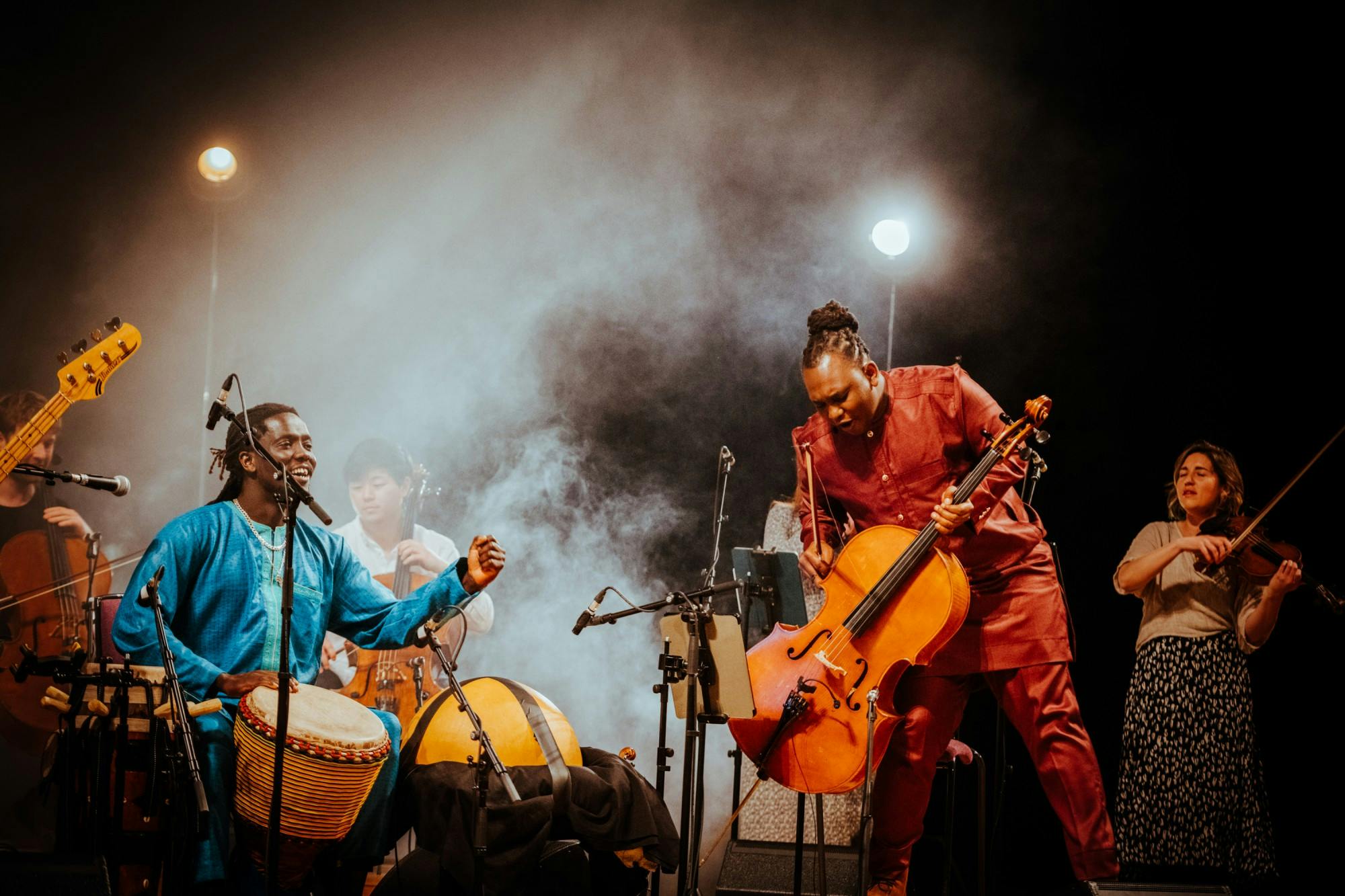The Manchester Collective, in collaboration with South African cellist Abel Selaocoe and the Chesaba trio, began their American tour of “Sirocco” at the Hopkins Center for the Arts on Thursday, Oct. 6. The Collective features violinists Rakhi Singh — the group’s music Director — and Sammy Singh, as well as violist Ruth Gibson. They were joined by Selaocoe who served as both the guest director and narrator of the performance, as well as bass guitarist Alan Keary and percussionist Dudu Kouate to compile a performance featuring a wide repertoire from multiple continents and cultural backgrounds.
The Manchester Collective was founded around six years ago and includes musicians based in and around Manchester, England — many of whom studied music together at the Royal Northern College of Music, according to Gibson.
The performance is titled “Sirocco,” which according to Selaocoe is the wind that blows from Africa to Europe — metaphorically, in this performance, representing the melding of traditions and cultures with the goal of bringing people together through music. Karen Henderson, the programming manager at the Hop, highlighted these themes of convergence as the works performed traverse both continents and time periods.
“We were very excited at the opportunity to present ‘Sirocco’ for the first time in the U.S.,” Henderson said. “Abel Selaocoe is a rising star who has been taking Europe by storm and this brilliant collaboration with Manchester Collective is a beautiful celebration of cultures from around the world that inspires joy, which is very much needed in this moment.”
The show began with an African piece, which included singing and instrumentation from each of the performers — after which Selaocoe explained the title of the program and the themes of connection. Following the first piece, Selaocoe, Keary and Kouate improvised on the theme of the cosmos and vibrations, which included using drums, the pouring of water and instruments that imitated the sounds of birds.
The performance later included “Three Preludes” by contemporary Danish composer Hans Abrahamsen, the Danish folk tune “O Fredrik, O Fredrik,” West and South African folk music, a movement from Joseph Haydn’s “String Quartet in G Major,” Selaocoe’s own “Kea Mo Rata,” and finally an encore featuring a piece which celebrates mothers and motherhood. As Selaocoe said, the piece explores how to “live with fear and trump it,” which was evident in the powerful instrumentation in the piece along with Selaoccoe’s deep vocalization.
Violist Ruth Gibson said the diverse performance was a combination of Selaocoe and Singh’s ideas.
“It’s kind of [Selaocoe’s] story. He’s from South Africa, so it’s his heritage, but also his relationship to classical music that he’s had since he started cello,” Gibson said. “And it’s just kind of music he loves, and what he thinks connects well, and how there’s quite a lot of links through rhythm that you’ll hear in the concert and even harmonically through Haydn all the way to the music of today.”
Joy and oneness with the music were evident themes in the performance itself. The musicians wore bright and colorful clothing, setting the stage for an energetic experience. Furthermore, during a later piece which included rhythms of West and South African traditional music, Selaocoe encouraged audience participation, including clapping and singing along.
Gibson said the musicians found joy and enthusiasm from collaborating with one another as well.
“We do lots of different things and are very explorative individually, so, while we love playing together, it’s also being influenced and inspired by each other,” Gibson said. “[Kouate] has the most incredible sayings and colors that you wouldn’t necessarily expect. And I think it’s knowing that there’s no kind of boundary on how to collaborate together.”
Boseong Kim ’26, who attended the event, highlighted the compounding of cultures that were evident in the performance.
“It was a classical performance, but … [Selaocoe] added his own African cultural twists to it, and a lot of sounds you would hear in traditional African music, like throat singing,” Kim said. “During the discussion, he said that music continues to evolve, and one way to do that is by combining cultures.”
Kim further added that it was one of the “coolest” performances he had attended.
“I didn’t know you could combine those cultures,” Kim said.




